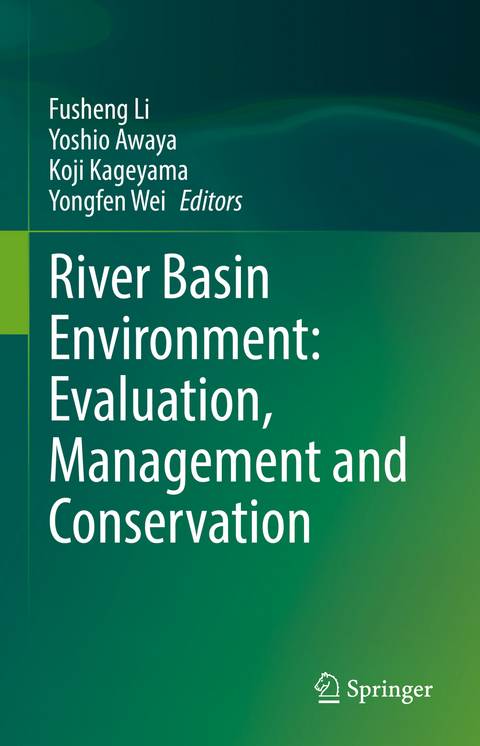
River Basin Environment: Evaluation, Management and Conservation
Springer Verlag, Singapore
978-981-19-4069-9 (ISBN)
Fusheng Li is a professor at the River Basin Research Center, Gifu University, Japan. His teaching and research activities are in the fields from water quality to water and wastewater treatment, and recently also to resource and energy recovery from organic waste. The ongoing research projects in his lab include activated carbon adsorption, membrane filtration, biological water and wastewater treatment, vermicomposting treatment of vegetable waste and activated sludge, and physicochemical and biological water quality evaluation. Dr. Li completed his PhD in March 1998 from Gifu University and has been a full professor at the research center since May 2008. He is also serving as the director of the research center now. Yoshio Awaya has been a Professor at the River Basin Research Center, Gifu University, Japan, since 2009. His research interests are remote sensing of the land ecosystem, especially forest and forestry. His research covers leaf to global scale of changesin ecosystem structure or biomass using field data, airborne and satellite optical sensors and airborne laser scanners. He received his PhD from Niigata University in 1995. He worked as a research scientist at the Forestry and Forest Products Research Institute of Forestry Agency of Japan from 1980 until 2009, prior to joining the River Basin Research Center, Gifu University. He was appointed as the president of the Remote Sensing Society of Japan between 2016 and 2018. Koji Kageyama has been an Emeritus Professor at River Basin Research Center, Gifu University, Japan, since 2021. His research interests include plant pathology, mycology, and molecular ecology of soil fungi. He received his PhD from Hokkaido University in 1983. He worked as a researcher in Aichi Prefectural Agricultural Experiment Station, as an assistant and associate professor in the Department of Agriculture, Gifu University, and as a professor in the River Basin Research Center, Gifu University, until 2021. Yongfen Wei is an associate professor at the River Basin Research Center, Gifu University, Japan. She is also a principal supervisor for master’s course education in the Graduate School of Natural Science and Technology, and doctoral course education in the United Graduate School of Agricultural Science of this Japanese national university. She received her BS degree in environmental engineering from the Lanzhou Jiaotong University of China in 1986, MS degree from Kitami Institute of Technology of Japan in 1995 and PhD degree from Gifu University in 2002. Her main research focus is environmental monitory and assessment, ranging from remote sensing application to mass dynamics analysis, and recently has also been working on topics relating to soil remediation. As a key member of the Gifu University Rearing Program for Basin Water Environmental Leaders (BWEL), she has been actively involved in all program teaching and managing activities with other faculty members together, leading the achievement of 230 master’s and doctoral graduates who learned under the program.
Chapter 1. Phenology of photosynthesis in a deciduous broadleaf forest: implications for the carbon cycle in a changing environment.- Chapter 2. Ecological significance of throughfall and stemflow to the carbon cycle in forest ecosystems.- Chapter 3.Forest carbon sequestration in mountainous region in Japan under ongoing climate change: implication for future research.- Chapter 4. Woody biomass change monitoring in temperate montane forests by airborne LiDAR analysis.- Chapter 5. Semi-natural grasslands maintained by controlled burning in Japan - Air and soil temperature and plant diversity.- Chapter 6. Detection and Identification of Phytophthora Pathogens That are Threatening Forest Ecosystems Worldwide.- Chapter 7. Water quality safety and security - from evaluation to control.- Chapter 8. Energy Recovery from Wastewater.- Chapter 9. Management of on-site household wastewater treatment systems (Johkasou) in Japan.- Chapter 10. Predicting fine sediment deposition rate in low-land river channel: Comparison of two adjacent rivers.- Chapter 11. Relationship between forest stand condition and water balance in a forested basin.- Chapter 12. Plant pathogenic oomycetes inhabiting river water are a potential source of infestation in agricultural areas.- Chapter 13. Soil contamination and conservation.- Chapter 14. Evaporation in arid regions.- Chapter 15. Feature Extraction and Analysis of Earthquake Motion.- Chapter 16. Involving the community to manage natural disasters: A study of Japanese disaster risk reduction practices.
| Erscheinungsdatum | 05.09.2022 |
|---|---|
| Zusatzinfo | 63 Illustrations, color; 89 Illustrations, black and white; X, 356 p. 152 illus., 63 illus. in color. |
| Verlagsort | Singapore |
| Sprache | englisch |
| Maße | 155 x 235 mm |
| Themenwelt | Naturwissenschaften ► Biologie ► Ökologie / Naturschutz |
| Naturwissenschaften ► Geowissenschaften ► Hydrologie / Ozeanografie | |
| ISBN-10 | 981-19-4069-X / 981194069X |
| ISBN-13 | 978-981-19-4069-9 / 9789811940699 |
| Zustand | Neuware |
| Informationen gemäß Produktsicherheitsverordnung (GPSR) | |
| Haben Sie eine Frage zum Produkt? |
aus dem Bereich


